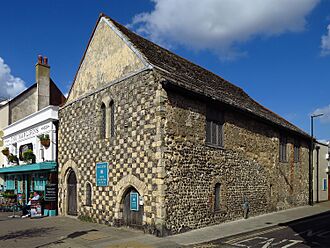Marlipins Museum facts for kids
Quick facts for kids Marlipins Museum |
|
|---|---|

The building from the southeast
|
|
| General information | |
| Architectural style | Norman |
| Location | 36 High Street, Shoreham-by-Sea, West Sussex, England |
| Coordinates | 50°49′55.18″N 0°16′34.25″W / 50.8319944°N 0.2761806°W |
| Governing body | Sussex Archaeological Society |
|
Listed Building – Grade II*
|
|
| Official name: Marlipins Museum | |
| Designated: | 8 May 1950 |
| Reference #: | 1353757 |
The Marlipins Museum is a very old and special building in Shoreham-by-Sea, a town in West Sussex, England. It was built a long, long time ago, between the 12th and early 13th centuries. What makes it stand out is its unique front wall. This wall has a cool checkerboard pattern made from light-colored limestone and dark flint stones.
This historic building is thought to be one of the oldest non-religious buildings still standing in Britain. It has seen many changes over the centuries. For example, its northern wall was first built between 1167 and 1197. Later, in the 15th century, a new wall replaced it.
The beautiful stone front, made from a type of stone called Caen stone, was likely added later. This happened in the late 13th or early 14th century. The building also had its roof repaired in the 15th century. New wooden beams were put inside during the 16th century to keep it strong.
Contents
What Was It For?
People have many ideas about what the Marlipins building was used for originally.
Early Ideas
Some people thought it might have been a place to store wool or animal hides. Others wondered if it was a hospital or even part of a Carmelite Priory, which is a type of religious building. There was also a theory that it was a meeting place for the Knights Templar, a famous group of medieval knights. However, there isn't strong proof for any of these religious uses.
Market Court or Depot?
A more likely idea is that the building served as a "Court of Piepowders." This was a special court for people who had "dusty feet" from traveling to markets. It was a quick court to settle arguments that happened right there at the market outside the building. It's also possible that a powerful family called the de Braoses built it. They lived at nearby Bramber Castle and might have used Marlipins as their storage place in town.
A Look Back in Time
The Marlipins Museum has a long and interesting past. We can learn about it from old documents called deeds.
Early Records
The oldest deeds for Marlipins go all the way back to 1347. These papers describe the building as an "Oat Market on the corner of Moderlove Street." Today, Moderlove Street is known as Middle Street. Later, when the building belonged to the Prior of Lewes, it was simply called "his cellar."
Key Dates in History
- 1346: Records show the Marlipins building was sold by Stephen Must. It was described as a stone building called 'Malduppine' in the Oat Market.
- 1488: Another important document from September 8, 1488, shows the building being sold again. It was called 'Malappynnys' then. It was described as a cellar with a room above it, located between "Moderlove strete" and "Procession strete."
- 1703: The name "Marlipins" as we know it today was first written down around this time.
Becoming a Museum
- 1922: The Sussex Archaeological Society bought the Marlipins building. They created a special group called the Sussex Archaeological Trust to look after their properties. The building was in bad shape, but local people helped raise money for its repairs.
- 1928: After being fixed up, the Marlipins building opened its doors as a museum. It's now one of several important places managed by the Sussex Archaeological Society.
Marlipins Today
Today, the Marlipins Museum is open to everyone. It has many interesting things to see.
What You Can See
The museum has displays that focus on Shoreham's important history with the sea. You can learn all about the town's past and the local area of Sussex. There's an Archaeology Gallery that shows what the Shoreham area was like from ancient times up to the medieval period. The museum also has a large collection of art. Pictures from this collection are often changed and shown in two newer galleries.
A Protected Building
The Marlipins building is very important. On May 8, 1950, it was given a special status by English Heritage. It was listed as a "Grade II* listed building." This means it's considered "particularly important" and has "more than special interest." In 2001, it was one of only six Grade II* listed buildings in the Adur district. There were 119 listed buildings of all types in the district at that time.
See also
- Grade II* listed buildings in West Sussex

